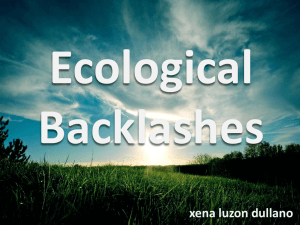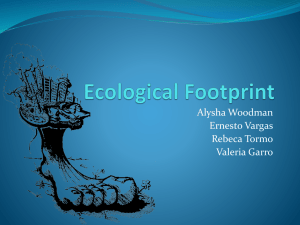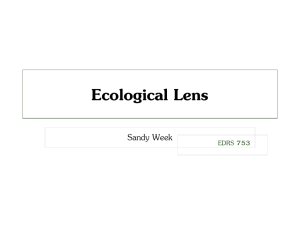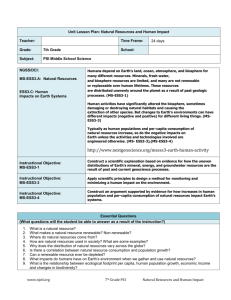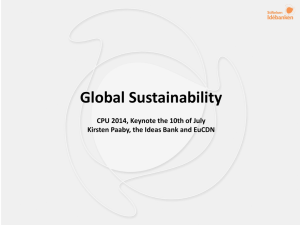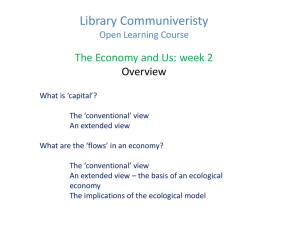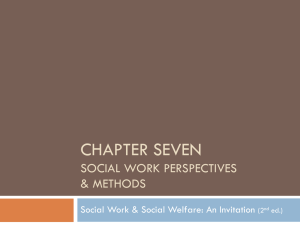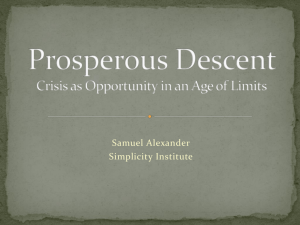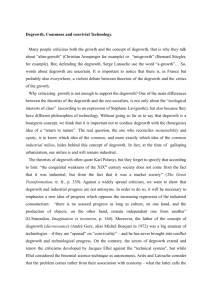Dr. Gabor Zovanyi - Fresh Outlook Foundation
advertisement
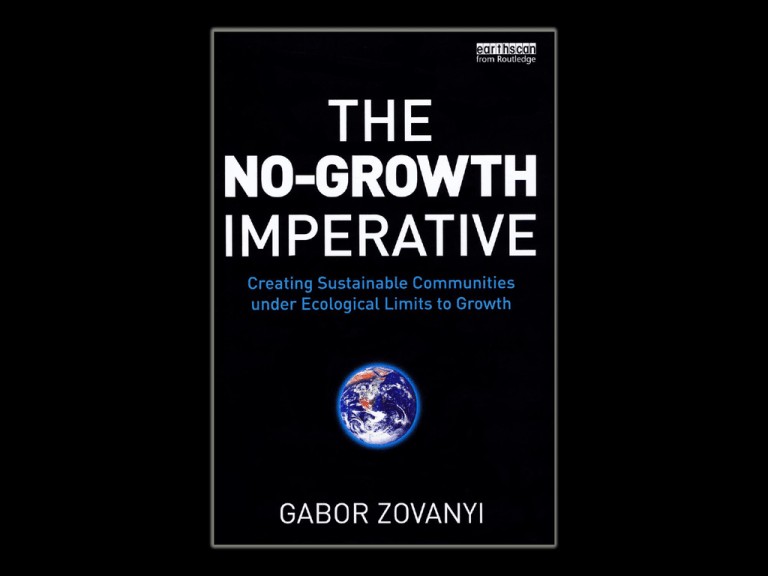
THE FIVE MOST IMPORTANT THINGS ABOUT GROWTH LEARNED OVER THE COURSE OF MY CAREER #1 Most people are captives of a cultural story that equates growth with progress. A cultural story that asserts growth as inevitable, necessary, desirable, and possible. Daniel Quinn’s 1995 novel Ishmael: A culture is a people enacting a story. We are currently enacting a story that compels us to destroy the world in order to live. #2 Growth is inherently unsustainable “It is development that can have the attribute of sustainability, not growth.” Herman E. Daly • Growth cannot be continued indefinitely. • The term “sustainable growth” represents a moronic oxymoron CASSA: Center for the Advancement of the Steady State Economy Position statement: There is an inherent conflict between economic growth and environmental protection based on the ecological principle of competitive exclusion US Society for Ecological Economics The Wildlife Society North American Section of the Society for Conservation Biology #3 More than two decades of mounting evidence confirms existent ecological limits to growth. The current level of human demands on earth’s ecosystems represents unsustainable behavior that can only be maintained over the short term. The collective ecological footprint of humans is degrading and destroying global ecosystems and their essential life-support services. Existent Ecological Limits to Growth 1991: Ecological Society of America Declared the existing scale of the human enterprise was “threatening the sustainability of Earth’s life-support systems” Ecological life-support services: Maintain a benign mix of atmospheric gases Control climate Regulate the hydrologic cycle Purify air and water Decompose wastes Regenerate soil nutrients Provide pest control and pollination Create and maintain biodiversity 1991 & 1992: Paul Ehrlich & Edward O. Wilson Warned that under current trends fully 50 percent of species on the planet could be eliminated by 2050 1997: Research on per capita ecological footprints Revealed the footprint of humanity already exceeded the planet’s ecological capacity to sustain the human enterprise 2005: Millennium Ecosystem Assessment Reported some 60 percent of the ecosystems that support life on Earth are being degraded or used unsustainably 2007:Intergovernmental Panel on Climate Change Called for a reduction of 80 percent in global emissions from 1990 levels to avert “dangerous anthropogenic climate change” IPCC Conclusions: A “safe” level of warming lies at 2° C (3.6° F) Even the 1° C (1.8° F) warming to date represents significant risks Most models suggest doubling carbon dioxide will lead to a temperature rise of 3° C (5.4° F) With feedback processes a 2010 study suggests a doubling would produce an increase of 9.6° C (17.3° F) with disastrous consequences 2009: Exceeded “planetary boundaries” Humanity has already pushed 3 of Earth’s 9 biophysical processes beyond the planet’s ability to self-regulate, with current trends leading to “catastrophic consequences” Planetary Boundaries: Boundaries for the rate of biodiversity loss, climate change, and human interference with the nitrogen cycle have already been exceeded Boundaries for the phosphorus cycle, stratospheric ozone depletion, ocean acidification, global freshwater use, change in land use, atmospheric aerosol loading, and chemical pollution are rapidly approaching 2010: 8th Living Planet Report Declared the collective ecological footprint of humankind exceeds Earth’s biocapacity by 50 percent 2012: Threat of a “state shift” in global ecosystem Global ecosystem rapidly approaching a planetaryscale critical transition or “state shift” as a result of human interference, with threats to the planet’s ability to sustain us and other species #4 The pro-growth stance of the planning profession impedes the necessary paradigm shift to a no-growth and degrowth future. Growth-management supports the growth imperative. The smart-growth movement represents continued professional planning support for growth. Current growth-management programs Growth management represents an institutionalized form of support for the growth imperative Management programs endorse inevitable, normal, realistic, reasonable, responsible, proper, sensible, legitimate, balanced, and smart growth Members of the management movement condemn no-growth initiatives as inefficient, unjust, and irresponsible responses to growth Adoption of no-growth and degrowth strategies Reject current growth-management programs due to their growth-accommodation orientation Implement political, economic, and planning and regulatory strategies to stop growth Devise a sustainable no-growth future, i.e., likely social, political, economic, and physical features of no-growth communities Strategies to stop growth Political: eliminate the pro-growth focus of local government by election or initiative Economic: stop public subsidies for infrastructure Planning & regulatory: modify community comprehensive plans and land-use regulations in ways that close out options for further growth #5 A sustainable no-growth future would be possible under community economics and new urbanism lifestyles. Features of community economics: needs-based economies directed at self-sufficiency through a diverse set of import-substitution businesses Features of new urbanism: urban places downsized and redesigned to levels that are ecologically sustainable within the capabilities of their bioregions Prospects for realizing no-growth communities Bioregionalism Voluntary Simplicity Slow Food Ecovillages Take Back Your Time Transition Town Degrowth


